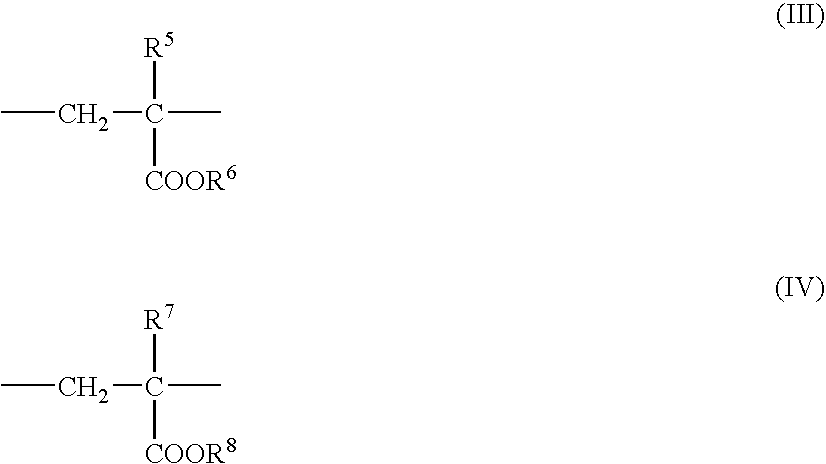Nanoparticles for delivery of a pharmacologically active agent
a technology of nanoparticles and active agents, applied in the field of nanoparticles for delivery of a pharmacologically active agent, can solve the problems of difficult modification of particle surfaces with functional molecules, significant reduction of supercoiled dna, and low encapsulation efficiency
- Summary
- Abstract
- Description
- Claims
- Application Information
AI Technical Summary
Benefits of technology
Problems solved by technology
Method used
Image
Examples
reference example 1
Synthesis of Ionic Monomer (1)
[0207] The ionic monomer 2-(dimethyloctyl)ammonium ethyl methacrylate bromine (1) was obtained by direct reaction of DMAEMA with 1-bromooctane. DMAEMA (0.166 mol) was mixed with 1-bromooctane (0.083 mol) without any additional solvent. After the addition of a small portion of hydroquinone to inhibit eventual radical polymerization reactions, the mixture was stirred at 50° C. for 24 h. The solid product so obtained was washed with dry diethyl ether to remove the excess DMAEMA. Finally, it was dried under vacuum at room temperature. The purity of the product was tested by 1H NMR spectra. Reaction yields were in the 55-65% range.
reference example 2
Synthesis of Fluorescent Monomer (3)
[0208] 2.0 g of fluorescein (6.0 mmol), 2.0 g of calcium carbonate and hydroquinone (trace) were dissolved in 100 ml of DMF, and the solution was heated at 60° C. Allyl chloride was added slowly dropwise and the reaction was allowed to proceed for 30 h in the dark. After vacuum evaporation of the solvent the product was purified by flash column chromatography (silica gel; diethyl ether-ethyl acetate 80:20 as eluent). Yield 53%, (m.p.=123-125° C.); MS, m / z (%): 412 (M+, 100), 371 (10), 287 (20), 259 (15), 202 (7); 1H-NMR (CD3OD): d 4.44 (dd, J=5.9 and 1 Hz, 2 H, O—CH2—CH═), 4.75 (dd, J=5.9 and 1 Hz, 2 H, O—CH2—CH═), 5.08 (m, 2H, CH2═CH), 5.40 (m, 2H, CH2═CH), 5.58 (m, 1H, CH2═CH), 6.10 (m, 1H, CH2═CH), 6.60 (m, 2H, Ar), 6.98 (m, 3H, Ar), 7.25 (d, J=1 Hz, 1H, Ar), 7.45 (dd, J=7.5 and 1 Hz, 1H, Ar), 7.85 (m, 2H, Ar), 8.30 (dd, J=7.5 and 1 Hz, 1H, Ar).
example 1
Nanoparticle Preparation
[0209] In a typical emulsion polymerization reaction, 6.0 ml (56.2 mmol) of methyl methacrylate were introduced in a flask containing 120 ml of an aqueous solution of the ionic monomer (1) obtained in Reference Example 1 and non-ionic polymer (2). The flask was fluxed with nitrogen under constant stirring for 30 min, then anionic KPS or cationic AIBA dissolved in water were added. The final amounts of initiator and comonomers in the various sample are listed in Table 1.
[0210] The flask was fluxed with nitrogen during the polymerization which was performed at 80±1.0° C. for 24 hours under constant stirring. At the end of the reaction, the product was filtered and purified by repeated dialysis, at least ten times, against an aqueous solution of cetyl trimethyl ammonium bromide, to remove the residual methyl methacrylate, and then water, at least ten times, to remove the residual comonomer. The nanoparticle yield, with respect to the total amount of methyl me...
PUM
| Property | Measurement | Unit |
|---|---|---|
| Particle size | aaaaa | aaaaa |
| Immunogenicity | aaaaa | aaaaa |
| Fluorescence | aaaaa | aaaaa |
Abstract
Description
Claims
Application Information
 Login to View More
Login to View More - R&D
- Intellectual Property
- Life Sciences
- Materials
- Tech Scout
- Unparalleled Data Quality
- Higher Quality Content
- 60% Fewer Hallucinations
Browse by: Latest US Patents, China's latest patents, Technical Efficacy Thesaurus, Application Domain, Technology Topic, Popular Technical Reports.
© 2025 PatSnap. All rights reserved.Legal|Privacy policy|Modern Slavery Act Transparency Statement|Sitemap|About US| Contact US: help@patsnap.com



